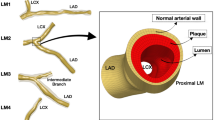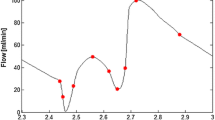Abstract
In recent years, interventional cardiologists have discussed over a new clinical issue called longitudinal stent compression (LSC), a failure mode not previously observed in coronary stents. This phenomenon occurs when the physician attempts to cross a deployed stent with a second device, causing the stent to dramatically shorten when two devices are accidentally entangled. While this phenomenon has been observed with a number of stent platforms, it seems more common with the Element stent. In this paper, a computational LSC model using finite element analysis was developed. A systematic investigation was conducted in attempts to quantify individual contribution of the stent design pattern, connector number, design parameter, and connector location on LSC. Computational simulations were performed on two representative coronary stents resembling Element and Endeavor for comparison. Simulation results show that the connector number plays the most significant role in LSC. The LSC could be easily tripled or quadrupled for the same stent design simply by increasing the connector number from two to three. The design pattern and design parameter play a secondary role in LSC, with the LSC improved by up to 30 and 65 %, respectively. It was also found that the LSC could be doubled for the Element stent simply by rearranging its connector location. This small design tweak could help improve the current Element LSC significantly, while still maintaining the majority of its excellent deliverability. These findings could provide great insights into this new clinical issue and help optimize future stent design to reduce the associated risk involved in LSC.












Similar content being viewed by others
References
M. Azaouzi, A. Makradi, S. Belouettar, Comput. Mater. Sci. 72, 54 (2013)
G. Finet, G. Rioufol, EuroIntervention 8, 177 (2012)
F. Gervaso, C. Capelli, L. Petrini, S. Lattanzio, L. Di Virgilio, F. Migliavacca, J. Biomech. 41, 1206 (2008)
C.G. Hanratty, S.J. Walsh, EuroIntervention 7, 872 (2011)
H.M. Hsiao, Y.H. Chiu, K.H. Lee, C.H. Lin, Comput. Aided Des. 44, 757 (2012)
H.M. Hsiao, Y.H. Chiu, T.Y. Wu, J.K. Shen, T.Y. Lee, Med. Eng. Phys. 35, 884 (2013)
H.M. Hsiao, A. Nikanorov, S. Prabhu, M.K. Razavi, J. Biomed. Mater. Res. B. 91B, 508 (2009)
H.M. Hsiao, J.A. Ormiston, J. Am. Coll. Cardiol. Intv. 5, 362 (2012)
H.M. Hsiao, M.T. Yin, Biomed. Microdev. 16, 133 (2014)
E. Janakiraman, V. Subban, S.M. Victor, A.S. Mullasari, Indian Heart J. 64, 518 (2012)
J.P. McGarry, B.P. O’Donnell, P.E. McHugh, J.G. McGarry, Comput. Mater. Sci. 31, 421 (2004)
F. Migliavacca, L. Petrini, M. Colombo, F. Auricchio, R. Pietrabissa, J. Biomech. 35, 803 (2002)
P. Mortier, M. De Beule, EuroIntervention 7, 773 (2011)
J.A. Ormiston, B. Webber, M.W. Webster, J. Am. Coll. Cardiol. Intv. 4, 1310 (2011)
A.R. Pelton, V. Schroeder, M.R. Mitchell, X.Y. Gong, M. Barney, S.W. Robertson, J. Mech. Behav. Biomed. Mater. 1, 153 (2008)
L. Petrini, W. Wu, E. Dordoni, A. Meoli, F. Migliavacca, G. Pennati, Funct. Mater. Lett. 5, 1250012 (2012)
S. Prabhu, T. Schikorr, T. Mahmoud, J. Jacobs, A. Potgieter, C. Simonton, EuroIntervention 8, 275 (2012)
J. Shannon, A. Latib, K. Takagi, A. Chieffo, F. Figini, F. Sacco, S. Ferrarello, M. Montorfano, A. Colombo, Cath. Cardiol. Intv. 81, 810 (2013)
M. Sungur, A. Celiker, T. Karagoz, K. Baysal, Int. J. Cardiol. 134, e29 (2009)
P.D. Williams, M.A. Mamas, K.P. Morgan, M. El-Omar, B. Clarke, A. Bainbridge, F. Fath-Ordoubadi, D.G. Fraser, EuroIntervention 8, 267 (2012)
H. Zahedmanesh, D.J. Kelly, C. Lally, J. Biomech. 43, 2126 (2010)
Acknowledgments
This research was supported by the National Science Council in Taiwan through Grants NSC-102-2221-E-002-130-MY3 and NSC-102-2622-E-002-017-CC1. The authors gratefully appreciate the support and help from the NSC.
Conflict of interest statement
The authors have no competing interests to declare.
Author information
Authors and Affiliations
Corresponding author
Rights and permissions
About this article
Cite this article
Hsiao, HM., Yeh, CT., Wang, C. et al. Effects of stent design on new clinical issue of longitudinal stent compression in interventional cardiology. Biomed Microdevices 16, 599–607 (2014). https://doi.org/10.1007/s10544-014-9862-4
Published:
Issue Date:
DOI: https://doi.org/10.1007/s10544-014-9862-4




